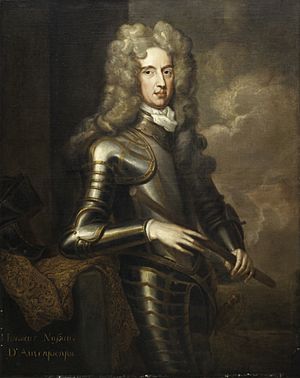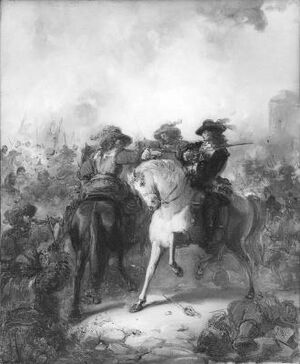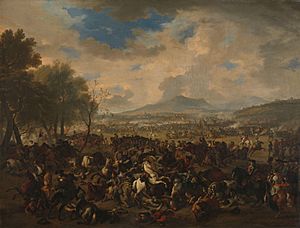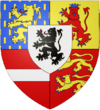Henry de Nassau, Lord Overkirk facts for kids
Henry, Count of Nassau, Lord of Overkirk (born 1640 – died 1708) was a Dutch military general. He was a second cousin to William III of England, who later became King of England. Henry was also William III's Master of the Horse, a very important role in the royal household. He was known in England as "Lord Overkirk" or "Count Overkirk".
Contents
Who Was Henry Overkirk?
Henry Overkirk was born in The Hague, Netherlands, on December 16, 1640. His father was Louis of Nassau-Beverweerd, and his mother was Isabella van Hoorn. In 1679, he was given the special title of Count of Nassau by Emperor Leopold I.
In 1688, Henry joined William III when he invaded England. This event is known as the Glorious Revolution. The next year, Henry was appointed the king's Master of the Horse. This meant he was in charge of the king's horses, stables, and travel. He lived in London, and his house, Overkirk House, later became part of the famous 10 Downing Street.
Henry Overkirk passed away on October 18, 1708, in Roeselaere, which is now in Belgium. He was buried in the Nassau-LaLecq Crypt in Ouderkerk aan den IJssel, Netherlands. His wife continued to live in Overkirk House until she died in 1720.
Henry's Military Adventures
Henry Overkirk started his military career when he was young. He fought in many important wars and battles.
Early Battles and Saving a King
Henry first fought in the Franco-Dutch War. He was injured in the Battle of Seneffe. Later, he became famous for saving William III's life during the Battle of Saint-Denis. William was fighting very close to the enemy. A French knight was about to attack William when Henry quickly shot the Frenchman.
The Dutch government was very thankful for Henry's brave act. They gave him an honor guard, fancy pistols, and golden decorations. William immediately made him a captain. After this, Henry went with William on most of his military campaigns.
Fighting in the Nine Years' War
In 1688, the Nine Years' War began. Henry went with William III during his invasion of England. He also fought in the Williamite War in Ireland, including the famous Battle of the Boyne.
Back in Europe, Henry chased away French cavalry at the Battle of Leuze. In 1692, he fought the French again in the Battle of Steenkerque. The next year, Henry became very well-known as the colonel of the Dutch bodyguard at the Battle of Landen. There, he bravely charged and defeated two French cavalry groups, capturing some flags and prisoners.
In 1695, he served under the Prince de Vaudemont. He was promoted to major-general in 1696 and general in 1697. William III made him an English citizen and also appointed him Chief Marshal.
Working with the Duke of Marlborough
In England, Henry met the Duke of Marlborough, a very famous military leader. Henry was appointed field marshal of the entire Dutch States Army during the War of the Spanish Succession. This was likely thanks to Marlborough's recommendation. Marlborough greatly respected Henry, admiring his steady bravery. Henry became Marlborough's trusted partner, fighting in almost every major battle and campaign during this war.
In 1702, Henry convinced Marlborough not to attack the French lines, even though Marlborough thought it was a good idea. In 1703, Henry and the Dutch army successfully stopped the main French army from attacking important cities like Liège or Maastricht. In 1704, Marlborough marched with some Allied troops to the Danube river to help the Holy Roman Emperor. Henry stayed in the Low Countries and defended the Allied position there without much trouble.
In 1705, he helped break through the French lines in Brabant at the Battle of Elixheim. Later, he was the only major Dutch leader who supported Marlborough's plan to attack the French armies. This plan failed because of some Dutch officials called "field deputies" who were attached to Marlborough's staff.
The next year, Henry played a huge role in the victory at the Battle of Ramillies. He personally led the cavalry on the left side of the army. During this battle, his kindness almost cost him his life. A Bavarian cavalryman surrendered, and Henry let him keep his sword. But the Bavarian tried to stab Henry when he turned away! Luckily, an Allied cavalryman saw it just in time and shot the Bavarian.
After this, Henry participated in the Battle of Oudenarde, where he was important in attacking the French army from the side. He passed away shortly after, during the Siege of Lille (1708).
Henry's Family
Henry Overkirk married Frances van Aerssen van Sommelsdijck in The Hague on October 2, 1667. They had eight children together, including five sons.
Their children included:
- Countess Isabella van Nassau (1668–1692)
- Lodewijk van Nassau (1669–1687)
- Lucia van Nassau (1671–1673)
- Henry Nassau d'Auverquerque, 1st Earl of Grantham (1673–1754)
- Cornelis van Nassau, Lord of Woudenberg (1675–1712), who sadly drowned at the Battle of Denain.
- Count Willem Maurits van Nassau (1679–1753), Lord of Ouwerkerk. He married his cousin Charlotte van Nassau.
- Frans van Nassau (1682–1710), who died in the Battle of Almenar.
- Lucia Anna van Nassau (1684–1744)
| Political offices | ||
|---|---|---|
| Preceded by Lord Dartmouth |
Master of the Horse to William III 1689–1702 |
Succeeded by In commission |
| Dutch nobility | ||
| Preceded by Title created |
Lord of Ouwerkerk ?–1708 |
Succeeded by Maurice Louis II of Nassau-Lalecq |






